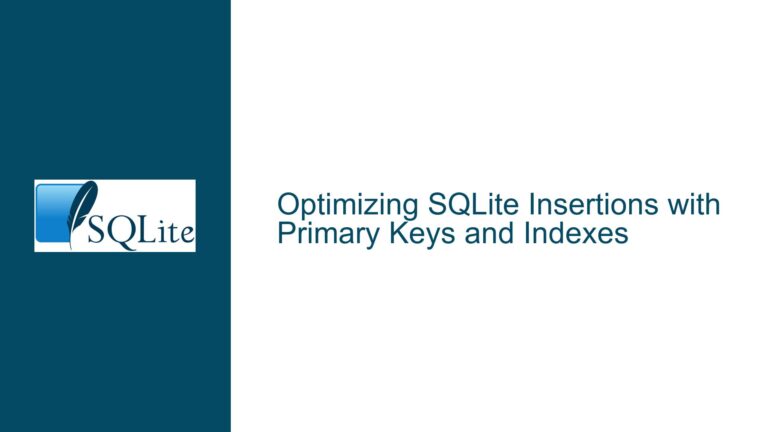Optimizing Aggregate Computations in HAVING and SELECT Clauses
Aggregate Function Redundancy in GROUP BY Filtering and Projection
Issue Context: Duplicate Aggregate Expressions in HAVING and SELECT
A common SQL optimization challenge occurs when developers write queries containing identical aggregate function calls in both the SELECT projection list and HAVING filter clause. The original poster observes that a query like SELECT SUM(item_count) AS totalitems FROM itemlist GROUP BY user_id HAVING SUM(item_count) > 50 appears to calculate the same SUM() twice – once for the result column and again for the filter condition. This pattern raises concerns about computational efficiency, particularly with complex aggregate expressions or large datasets. The core tension lies in SQL’s logical processing order: HAVING operates on grouped results while SELECT defines output columns, creating an apparent need to re-specify aggregates.
Three critical aspects define this challenge:
- SQL’s logical query processing sequence (FROM → WHERE → GROUP BY → HAVING → SELECT → ORDER BY)
- SQLite’s actual implementation of aggregate computations
- The optimizer’s ability to recognize and reuse equivalent expressions
The confusion stems from surface-level syntax requirements versus underlying execution realities. While SQL syntax forces developers to write aggregate expressions in both clauses, the bytecode analysis reveals that SQLite’s virtual machine often computes these aggregates only once when semantically equivalent. This behavior becomes non-obvious when examining raw SQL text, leading to unnecessary query restructuring attempts.
Execution Plan Analysis and Determinism Concerns
The apparent duplication of aggregate functions triggers valid performance concerns, but actual computation behavior depends on multiple factors:
1. Query Structure and Index Usage
Covering indexes containing both GROUP BY keys and aggregated columns enable storage engine optimizations. The provided index idx on itemlist(user_id, item_count) allows SQLite to scan ordered groups directly, minimizing aggregation overhead. When such indexes exist, the optimizer can compute aggregates through incremental accumulation during the index scan rather than full table processing.
2. Expression Complexity and Determinism
User-defined functions or volatile expressions might break computation reuse. The test case using testfunction(b) demonstrates that SQLite will reuse previous computations even for non-deterministic functions within the same query scope. This reveals an implementation detail: aggregate values get materialized during the grouping phase and reused in subsequent projection and filtering phases unless query structure forces recomputation.
3. Temporary B-Tree Usage
Queries without appropriate indexes trigger USE TEMP B-TREE FOR GROUP BY in the execution plan, forcing full table scans and temporary storage of grouped results. This implementation detail affects whether aggregate values get cached or recomputed. The sorter operational codes in the bytecode examples show how grouped rows get stored in temporary structures, with aggregates computed during the initial grouping pass.
4. Correlated Subquery Handling
When developers attempt to "optimize" by wrapping aggregates in subqueries (as shown in Message 7), they often inadvertently create less efficient execution plans. The CO-ROUTINE SUBQUERY pattern demonstrates how SQLite handles derived tables, sometimes adding unnecessary materialization steps compared to direct aggregation.
5. Bytecode-Level Computation Sharing
Analysis of the provided VDBE (Virtual Database Engine) opcodes reveals critical implementation behaviors. The AggStep opcode appears only once per aggregate function in the main processing loop, regardless of how many times the aggregate gets referenced in HAVING or SELECT. The AggFinal opcode that converts accumulator state to final values also appears once per aggregate, confirming single computation.
Query Optimization Techniques and Verification Methods
Step 1: Validate Actual Computation Count
Use SQLite’s EXPLAIN and deterministic test functions to observe computation frequency:
CREATE TEMP TABLE debug_log (msg TEXT);
CREATE TEMP FUNCTION log_counter(x) RETURNS x BEGIN INSERT INTO debug_log VALUES(x); RETURN x; END;
SELECT SUM(log_counter(item_count)) AS totalitems
FROM itemlist
GROUP BY user_id
HAVING SUM(log_counter(item_count)) > 50;
SELECT COUNT(DISTINCT msg) FROM debug_log; -- Returns 1 if computed once
Step 2: Analyze Query Plans with Different Indexes
Compare execution plans with and without covering indexes:
-- Without index
EXPLAIN QUERY PLAN
SELECT SUM(item_count) FROM itemlist GROUP BY user_id HAVING SUM(item_count) > 50;
-- With covering index
CREATE INDEX idx_group_optim ON itemlist(user_id, item_count);
EXPLAIN QUERY PLAN
SELECT SUM(item_count) FROM itemlist GROUP BY user_id HAVING SUM(item_count) > 50;
Step 3: Leverage Window Functions for Multi-Pass Aggregates
When needing to filter and project different aggregates derived from the same base calculation:
SELECT user_id, totalitems
FROM (
SELECT user_id, SUM(item_count) AS totalitems,
SUM(SUM(item_count)) OVER () AS grand_total
FROM itemlist
GROUP BY user_id
)
WHERE totalitems > 50;
Step 4: Utilize Common Table Expressions for Complex Aggregates
For scenarios requiring multiple aggregate-based filters:
WITH grouped AS (
SELECT user_id, SUM(item_count) AS totalitems,
COUNT(*) AS transaction_count
FROM itemlist
GROUP BY user_id
)
SELECT user_id, totalitems
FROM grouped
WHERE totalitems > 50 AND transaction_count > 5;
Step 5: Benchmark Subquery vs Direct Aggregation
Compare performance of different formulations using SQLite’s runtime measurements:
-- Direct aggregation
.timer on
SELECT SUM(item_count) FROM itemlist GROUP BY user_id HAVING SUM(item_count) > 50;
-- Subquery version
SELECT item_sum FROM (
SELECT SUM(item_count) AS item_sum
FROM itemlist
GROUP BY user_id
) WHERE item_sum > 50;
Step 6: Force Materialization with TEMP Storage
Test whether intermediate materialization helps complex aggregates:
CREATE TEMP TABLE grouped_items AS
SELECT user_id, SUM(item_count) AS totalitems
FROM itemlist
GROUP BY user_id;
SELECT totalitems FROM grouped_items WHERE totalitems > 50;
Step 7: Optimize Function Determinism
Mark custom functions as deterministic when possible to enable optimization:
CREATE TEMP FUNCTION complex_agg(x) RETURNS INTEGER DETERMINISTIC
BEGIN
-- Expensive computation
RETURN result;
END;
SELECT complex_agg(item_count) AS calc
FROM itemlist
GROUP BY user_id
HAVING complex_agg(item_count) > 100;
Step 8: Analyze VDBE Opcode Patterns
Use EXPLAIN to view low-level execution steps and verify aggregate reuse:
EXPLAIN
SELECT SUM(item_count) AS totalitems
FROM itemlist
GROUP BY user_id
HAVING SUM(item_count) > 50;
-- Look for single AggStep/AggFinal opcodes
Step 9: Profile Memory and CPU Usage
Use SQLite’s internal stats to measure actual resource consumption:
.stats on
SELECT SUM(item_count) FROM itemlist GROUP BY user_id HAVING SUM(item_count) > 50;
-- Observe 'bytes allocated' and 'cpu_time' in output
Step 10: Consider Schema Denormalization
For frequently queried aggregates, precompute and store them:
-- Add maintained aggregate column
ALTER TABLE itemlist ADD COLUMN user_total INTEGER;
CREATE TRIGGER update_totals AFTER INSERT ON itemlist
BEGIN
UPDATE itemlist
SET user_total = (
SELECT SUM(item_count)
FROM itemlist AS i2
WHERE i2.user_id = NEW.user_id
)
WHERE user_id = NEW.user_id;
END;
Final Recommendations:
- Prefer direct HAVING references to aliased aggregates rather than assuming duplication
- Always validate actual computation counts through EXPLAIN and function side-effects
- Create covering indexes matching GROUP BY and aggregate columns
- Use window functions instead of subqueries when needing multiple aggregate passes
- Mark custom aggregate functions as DETERMINISTIC when appropriate
The key insight lies in SQLite’s ability to optimize aggregate reuse despite syntactic duplication. Performance issues should be proven through bytecode analysis and profiling rather than assumed from query structure. Schema design and index strategy often outweigh micro-optimizations of aggregate expression duplication.






